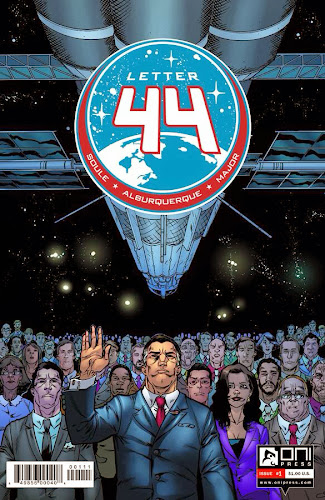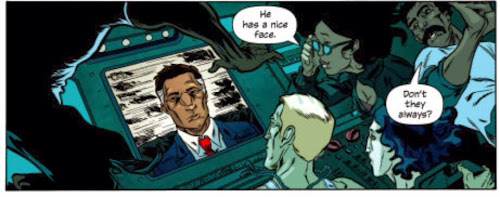Epic in scope, claustrophobic in execution - why I love Charles Soule's political Sci-Fi thriller; and why you should too.
ONI Press. Soule, Alberquerque, Major.
Warning: this article contains spoilers for issues 1-4 of Letter 44.
By the time of this writing, Letter 44 - ONI Press' new series by writer du jour Charles Soule and by artist Alberto Alberquerque - is on issue number 4 (really no excuse not to play catch up), but there is so much going on you'd be forgiven for thinking there'd been as many as the title may suggest. But no; the title is referring to the final act of exiting U.S President Francis Carroll, namely a letter to his successor - an apparently standard practise for Presidents to do on their hand over. However, what newly appointed President Stephen Blades discovers within said letter is anything but standard.
In it, Carroll explains away all of his questionable actions during his time in office - all of the pointless wars, all of the sketchy foreign policies, all of the highly suspect economic decisions he made - all explained away with "one essential fact", what he calls "the biggest secret of them all"... that seven years ago what appears to be an alien mining operation was discovered in an asteroid belt between Mars and Jupiter, and that he has spent all his presidency since that discovery not only sending a manned mission up to find out as much as they can, but pumping as much funding, time and effort into preparing his country for a potential invasion.
I came to this book with issue 3, but after reading the premise and flicking through the issue I picked up parts 1 and 2 straight away. It's such a simple concept: what if your government was hiding from you something so life altering and so scary that revealing it would potentially cause mass panic? What if the conspiracy theorists were right, that we are not alone? And how would that information affect our current political climate? Never more relevant than in light of recent revelations involving the NSA, these are nevertheless questions Charles Soule asks of the reader and of the characters within the story.
The beauty of Letter 44 is not the brilliantly simple premise, but in the delivery of that premise. There is no omnipresent narrator, no cuts to the aliens and their mysterious plans, no fourth wall breaking revelations; we find out information as and when the characters do. The first we hear about Project Monolith (the government's plan to investigate and prepare for the "visitors", and a subtle reference to Soule's Sci-Fi influences) is right when Blades opens that letter. We're there in the meetings as he uncovers everything they have learned so far, and we're there when the deep space crew onboard the Clarke first come into contact with whatever is out there. This not only serves to make the investigations of all the characters more relatable, but totally immerses you in their world. After all, this is very close to our world - politically, societally and technologically - which helps to play up the tension and the terror. It is in our very nature to be afraid of the unknown, and there is so much unknown in this story so far.
Attempting to uncover that 'unknown' are two very distinct but not dissimilar groups. Firstly there is the very much Earth based President Blades, who is surrunded by only a small gathering of staff that know all the details (and as the story progresses it's not certain all of those can be trusted). These moments on Earth are Blades story; he comes into his new post as Commander in Chief with many plans for reform and with big ideas surrounding the 'mistakes' of the previous administration, and in one short letter all of that unravels. The weight of command, of the responsibility, and of the truth bear heavy on his shoulders, and the promises made on his campaign trail become harder and harder to fulfil. His predecessor Carroll knows this burden and is seemingly eager to hand over the reigns. At the end of his letter he explains that he is done. He's out. And in a way you can understand why - he's sick of being hated in public for doing what he sees as the right thing in secret.
Despite his initial trepidation, Blades immediately sets out to uncover as much as possible, visiting with all chiefs of staff and Project Monolith itself to bring himself, and us, up to speed. There's a great page in issue 2 that's split into 4 widescreen panels, each showing off a different weapon being developed behind closed doors. All of this leads him to a monumental decision: to continue the ideals of former President Carroll and work in secret, planning for what many see as an inevitable invasion; or to go public and reveal Project Monolith to the world, with the only assurance being that no one really knows for certain why the visitors are there. One of the highlights of the (admittedly short) series so far is the opening monlogue from issue 2. In this speech, delivered by Head of Project Monolith Doctor Portek, writer Charles Soule rationally, calmly and systematically lays out all that can possibly be surmised from an alien presence of this kind in our Solar System. It's a thoroughly sobering moment for President Blades and for us as readers, and the series has rarely been more chilling or realistically scary.
The second group out to uncover the truth is off in deep space. There are 9 personnel (4 military, 5 scientific) that make up the crew of the Clarke; tasked with breaking through the 'curtain' that surrounds the extraterrestrials which blocks all attempts to remotely scan them. As you read through these early issues it's revealed that this dysfunctional band of explorers have been travelling for 3 years to reach their target, and in that time they've established a close-knit society, one with its own norms and rules that can only be embraced by a group of people that are in such close proximity for an extended period of time. As one of the crew explains in issue 3 "no one has anyone. If you ask and they say yes, then no one can say a word". A good idea in theory - a very human attempt to satisfy the common urges that would rear up when any set of people are thrown together like this, while trying to also address the insular nature of their situation - but seemingly harder to maintain in practise. Take Mission Commader Charlotte Hayden; they've been in space for 3 years, and yet she's 9 months pregnant. When the ships doctor asks if she'd like to know the father of the baby (to which she replies that she wouldn't, explaining that this is everyone's baby) you get an idea of the kind of issues their rules have raised. Throw in very obvious tensions between the two potential fathers and you sense a crew on the edge of unravelling, despite their obvious closeness.
There's also a more all-encompassing problem with the crew of the Clarke. In issue 3 we learn (again, at the same time as President Blades) that their deep space mission does not have enough fuel for a return journey; theirs is very much a one-way trip. If this was not troubling enough it's revealed that not only are they all aware of this fact, but that knowing this they all "jumped at the chance" of signing up. Why? Is it because of the thrill of the mission? For the love of their country? Or are they on the run from their previous lives? Time will tell.
It's clear here that Soule and Albequerque are weaving a complex science fiction narrative. Both Blades' story in the White House and the Clarke's story in space are extremely claustrophobic; metaphorically in the former's case, very literal in the latter. The fast pacing of the plot combines with the layouts on the page (the final splash pages being a particular highlight) and the dark, enclosing colour pallette of Guy Major all result in an almost unbearable level of tension that ratchets up after every issue.
Although it may seem like you now know everything there is to know about these first few issues, I've barely scratched the surface. From the extreme long distance shot of earth on the first page of issue 1 (deliberately at odds with the close, tight, claustrophobic nature of the book) to the extreme WTF final splash page of issue 4 (seriously...WTF...) there's lots to discover and love. Like the characters, the less you know, the more you'll want to find out, so I won't spoil any more here.
And if you needed any more of an excuse to check this series out, io9 have the entire first issue up on their site here. Go! Read!).
Until next time,
Matt

















I need to read this.
ReplyDelete